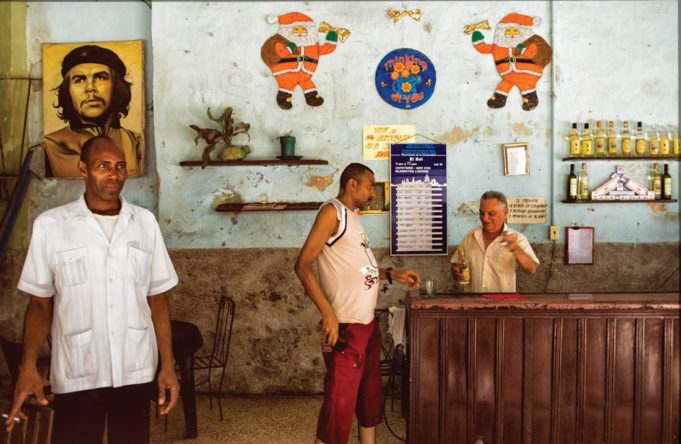In the nearly 17 years or so that photographer and historian David LaFevor has been traveling to Cuba, first as a student and then as a researcher, he has definitely proven he has an eye for capturing the spirit and heart of this fascinating island nation.
A new exhibit of his extraordinary images draws from his many journeys to the Caribbean locale. Cuba: Histories of the Present opens Friday and will run through Aug. 3 in the gallery space at Artes de la Rosa on the North Side.
Though the Nashville native-turned-Texas transplant is largely self-taught, LaFevor did receive some tutelage and inspiration from his father, a professional photographer. “For him, the equipment and techniques were more of a distraction,” LaFevor said of his father’s work. “He was much more of an aesthetically minded person.”
LaFevor’s work has received international acclaim, with notices in The New York Times, Washington Post, Chicago Tribune, Huffington Post, and many other outlets. His photos have also appeared in a dozen solo exhibitions throughout the country and in his first book, The Third Century: U.S.-Latin American Relations Since 1889, published in 2017.
“This [exhibit] is a collection of photography really starting in 2003, 2004,” he said. “I can look at any image and know whether it was one from when I was just starting out or a fairly recent one based on my interest at the time or the quality and forethought that goes into the photograph.”
LaFevor’s first foray into photography came as a student at the University of Havana in 2001. He walked the streets of the city trying to recreate the images taken by American photographer Walker Evans in the 1930s.
Since the urban architecture of the city has changed very little since the late 1950s, many of the buildings from Walker’s photos remain. Finding these places — often in obscure backstreets — gave LaFevor opportunities to collaborate with everyday Cubans whom he otherwise would have had no reason to speak to.
LaFevor said that he walked around with Evans’ prints, knocking on doors, finding the oldest living residents, and jogging their memories. He was amazed to find that elderly Cubans not only knew most of the buildings, barbershops, and courtyards photographed by Evans but recognized and named the people captured, sometimes surreptitiously, by Evans’ lens.
Much of LaFevor’s work is informed by his full-time job as a professor at the University of Texas at Arlington, where he teaches undergraduate courses on Colonial and Modern Latin American History and upper-division seminars on revolutions in Cuba and Mexico, nationalism, sport and gender, and slavery in the Western Hemisphere.
He took most of the images in conjunction with his ongoing historical preservation project of slave-era documents in Cuba’s oldest churches, which brings LaFevor to the island several times a year. For more on LaFevor’s Cuba travels, see the cover story on pg. 7.
The exhibit will feature approximately 30 images ranging from portraiture and street photography to interiors of rooms and detailed vignettes.
“One of the images is of an old boxer whom I encountered while working on my current book,” LaFevor says, referring to Prizefighting and Civilization: Race, the Public Sphere, and Identity in Cuba and Mexico, 1840s-1940s, which is currently awaiting publication. “He was in his late 70s or early 80s, and I have a shot of his hands showing me the scrapbook that he kept from the 1950s onward.”
LaFevor’s lens finds beauty in the everyday, from the rusty grill of one the many classic cars maintained as a necessity of everyday life by Cuban drivers to a stunning view of the Havana streets at dusk, awash in myriad shades of blue.
But the pictures that haunt you are his unforgettable portraits of Cuban street life, whether it’s young boys diving in the waters of the Bay of Havana, construction workers toiling in the unforgiving sun, denizens waiting their turn for a trim in the local barber shop, or the many close-ups of wizened faces ravaged by years under an aging political dictatorship yet still maintaining a twinkle of hope in those smiling eyes.
“They’re the types of images I wish existed for the period I wrote about because they’re not formal, they’re not really very well planned, they’re kind of immediate and in the moment,” LaFevor said. “I hope to capture some of the changes and continuities that will provide Cubans with the stuff of daily life for years to come.”
For Avi Hernandez, Artes de la Rosa managing director, LaFevor’s images were a perfect fit for an organization dedicated to preserving, promoting, and interpreting the art, lives, and history of Latino culture.
“The photographs are incredible,” Hernandez said. “They communicate the story of Cuba, its people and culture, unfiltered by the bias of politics. The images share our common humanity, the story of us all as members of an extended familia.”
Cuba: Histories of the Present
Opens 6-8pm Fri at Artes de la Rosa, 1140 N Main St, FW. Free. 817-624-8333.












